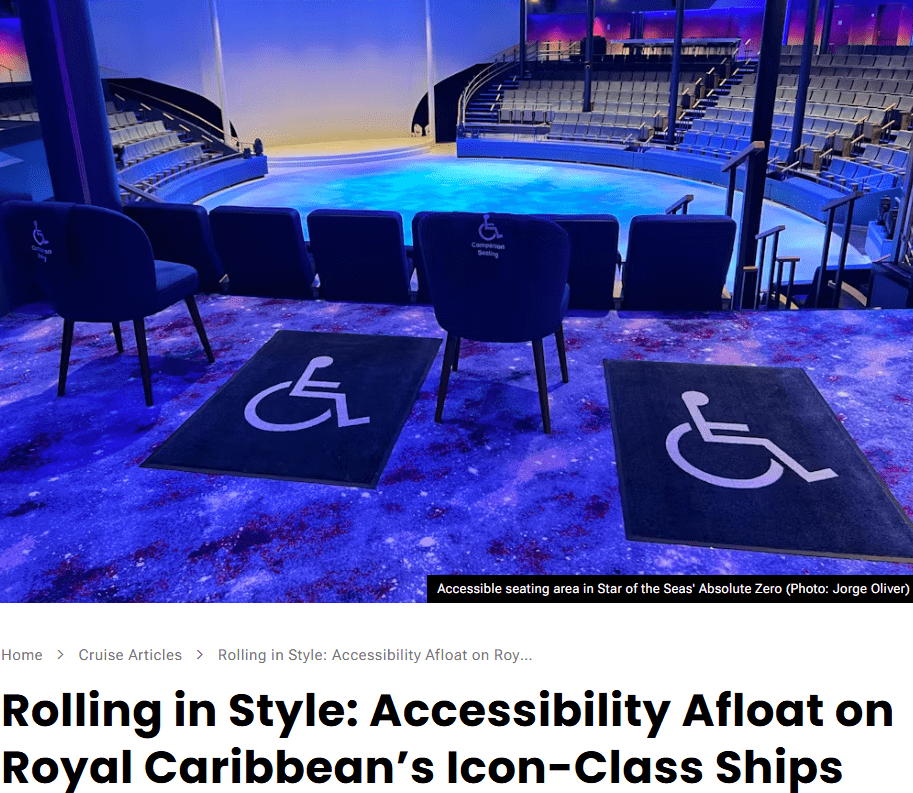A big thank you to Susan J. Young for highlighting Andrew Garnett’s experience aboard Royal…
Rollator vs Wheelchair: Understanding the Differences and When to Use Each
Choosing between a rollator and a wheelchair is more than a simple walking aid comparison—it’s a safety, independence, and comfort decision. This article defines each device, outlines who benefits, and explains practical trade-offs for homes, travel, and shore excursions. As Special Needs At Sea experts, we translate clinical essentials into clear guidance so you can select confidently and stay mobile.
Table of Contents
Understanding the Rollator
The rollator is a wheeled walking frame—three or four wheels, handlebars, hand brakes, often a seat and storage. It suits people who can bear weight and walk but need balance support and periodic rests. Fit is key: set handles near the wrist crease for a slight elbow bend, stay close to the frame, and avoid overreaching. Use brakes wisely—squeeze to slow, push down to lock before sitting. Turn with short steps inside the frame, and use ramps for curbs; for low thresholds, slow with both hands ready on the brakes. Wheel size shapes indoor versus outdoor comfort and shock absorption. Keep upright posture and an even step pattern. Respect weight limits, including cargo, and maintain tires, cables, and bolts. Versus a standard walker it moves faster and needs control; versus a wheelchair it keeps you walking but needs endurance.
- Measure handle height at wrist crease with arms relaxed.
- Choose wheel diameter for terrain and shock absorption.
- Check seat width, frame material, and foldability for travel.
Understanding the Wheelchair
A wheelchair is a mobile seating system that replaces walking when gait is unsafe or overly taxing. Manual self-propelled chairs have large rear wheels and push rims; transport chairs use small rear wheels and rely on a caregiver. Power chairs add motors and a joystick for precise, low-effort control. Indications include severe fatigue, high fall risk, need for posture support, and pressure management.
Core parts and safety: reliable wheel locks, anti-tippers, swing-away or elevating footrests, correct seat width/depth, an appropriate cushion (foam, gel, or air), and supportive backs that hold neutral alignment. Turning radius governs indoor maneuvering; practice straight approaches and controlled stops on ramps.
- Pressure relief: shift weight every 30–60 minutes for 30–90 seconds; match cushion to skin risk and comfort; inspect skin daily.
- Slopes and thresholds: aim for 1:12 ramps; avoid steep or wet surfaces; handle thresholds under 1/2 inch; use a spotter when in doubt.
- Transport: note chair weight, folding or quick-release wheels, and visible tie-down points.
Caregivers assist with spotting, transfers (locks on, footplates up, armrest out), and vehicle loading. Compared with a rollator, the wheelchair conserves energy and offers superior stability, expanding access though walking practice is reduced. Travel well by checking tires, bearings, and brakes; charge batteries; protect joysticks; secure cushions and straps.
Choosing Based on Mobility and Safety
Choose by function. If your legs bear weight with light hand support, a rollator may work; if weight-bearing is unreliable or painful, a wheelchair protects from collapse. Unsteady balance or unsafe multitasking while walking points to the chair. Endurance matters: household distances with pauses fit a rollator; longer or time‑sensitive trips favor a chair. Hands and mind count: reliable grip and brake judgment for a rollator; shoulder endurance or caregiver help for a wheelchair. Check door widths, thresholds, slopes, and surfaces. Weigh fall history and caregiver availability.
Scenarios: Post‑surgery—start chair, shift to rollator as strength returns. Progressive neurological disease—adopt chair early; keep rollator for short practice. Cardiopulmonary fatigue—chair for distance, rollator for brief tasks. Cruise excursions—cobbles and queues favor chairs; flat decks suit rollators.
- If near-falls, unsafe veering, or inability to clear obstacles occur, prioritize wheelchair safety.
- If steady gait returns with light support and rests, a rollator may optimize independence.
- Reassess needs after therapy, recovery milestones, or medication changes.
Travel Readiness and Real-World Use
Turn decisions into routines before embarkation. Before every outing, perform quick brake checks; levers should lock firmly and cables feel even. For a rollator, sit only with brakes locked, back fully against the seat, feet flat, and no scooting while seated. On ramps and gangways, control pace: keep hips close to the rollator, short steps, and descend slowly; with a wheelchair, use anti-tippers, lean forward uphill and slightly back downhill, and coordinate a steady count with your companion. Curb and elevator etiquette matters: approach curbs straight; for wheelchairs, a gentle tilt from the push handles, for rollators, step up with the stronger leg first. In elevators, enter and exit front-first unless space dictates backing out.
Plan storage and transport early. Fold devices to fit narrow cabin doors; remove baskets and cushions to free floor space. In hotels, request a clear 36-inch path; in vehicles, measure trunk height and consider quick-release wheels.
Carry documentation: device measurements, weight, and battery specs; airlines may require watt-hours for lithium packs, terminals taped, and batteries carried on if detachable. Reserve rentals for pier delivery and return, and schedule service windows. Maintain daily: wipe salt spray, check tires, axles, and fasteners; pack spares you’ve tested.
- Carry a repair kit, spare tips or pads, and labels with contact info.
- Protect frames with covers; remove accessories before gate-check.
- Photograph device condition and keep measurements and model numbers handy.
Conclusion
Both devices serve different mobility profiles. A rollator supports safe walking with rest options; a wheelchair preserves energy and stability when walking is unsafe or impossible. Use this walking aid comparison to match goals, environment, and medical needs. As Special Needs At Sea/Special Needs Group professionals, we encourage professional assessment and hands-on trials before travel so you stay independent and protected.



